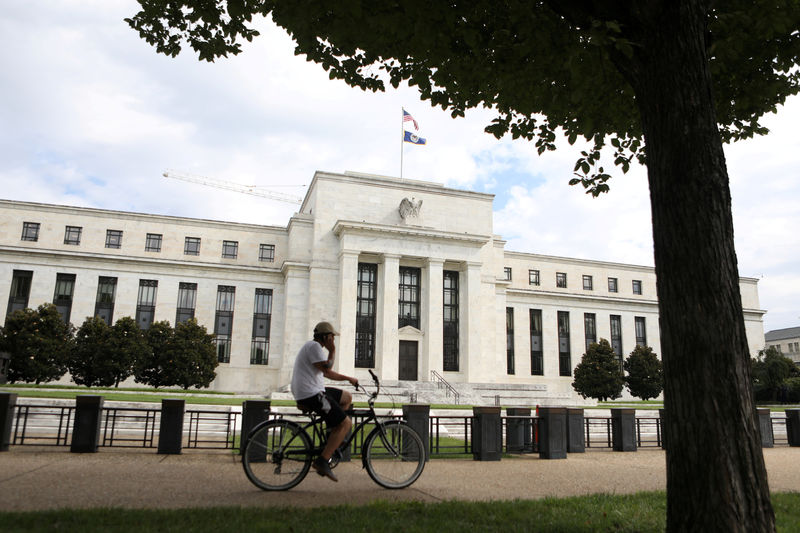 © Reuters. A cyclist passes the Federal Reserve building in Washington, DC
© Reuters. A cyclist passes the Federal Reserve building in Washington, DCBy Howard Schneider
JACKSON HOLE, Wyo. (Reuters) – U.S. President Trump may be unhappy with the Federal Reserve’s interest rate hikes, but it is a different Fed program that may weigh on the fate of his economic policies as the central bank shrinks its crisis-era bond holdings with no clear sign of when it will stop.
The drawdown of assets on the Fed’s balance sheet was set on “autopilot” nearly a year ago so that holdings would diminish steadily without further action by policymakers. With the central bank now liquidating tens of billions of dollars each month from its $4 trillion stock of Treasury bonds and mortgage-backed securities, lowering demand for those types of securities, it has edged mortgage and other long-term rates higher and made it more expensive for families to own homes or businesses to raise money to invest.
Trump “sees the Fed as a traditional Fed that raises and lowers interest rates that then have an impact on borrowing costs,” said Gregory Daco, chief U.S. economist at Oxford Economics. “In the current context you have the unconventional balance sheet, which the president has not alluded to.”
“As the Fed allows those assets to mature, it will put upward pressure on long-term yields.”
(Graphic: Federal Reserve balance sheet size: https://reut.rs/2OXMlY5)
That may already be happening as mortgage rates rise, and mortgage applications and existing home sales both fall, taking wind from a critical industry.
The Fed’s short-term interest rate, by contrast, remains low by historic standards, and even central bankers are uncertain if it remains as influential as it once was as a tool to manage the economy. It is the increases in that policy rate, directly under the Fed’s control, that Trump has criticized on several occasions, most recently in a Reuters interview on Monday.
In minutes released on Wednesday of the Fed’s meeting three weeks ago, policymakers indicated they were ready to continue their regular interest rate hikes. They also gave no indication that their balance sheet policy, in effect a shadow tightening of the long-term rates critical to economic growth, will change any time soon.
“A couple of participants” in that meeting pushed for more active debate about the balance sheet and related issues, but there seemed to be a lack of urgency.
“The Chairman suggested that the Committee would likely resume a discussion of operating frameworks in the fall,” the minutes reported.
Fed Chairman Jerome Powell will address a research conference here on Friday. While the topic of his remarks is broad – “Monetary Policy in a Changing Economy” – the debate over the final size and composition of the balance sheet is among the major outstanding issues as the Fed phases out crisis-era policies. It is far more nuanced than traditional policy actions like raising or lowering rates to slow or speed the economy.
The asset holdings accumulated during years of quantitative easing have been a frequent target of criticism from members of Trump’s own Republican party, who want the Fed to reduce its footprint in financial markets.
(Graphic: The Federal Reserve’s balance sheet is shrinking: https://reut.rs/2LjCKZx)
Last year the Fed kicked off a plan to allow a steadily increasing amount of holdings to mature each month without being reinvested. As of August, that stood at around $40 billion per month of “quantitative tightening.” The pace will hit its maximum of $50 billion a month in October.
Economists have estimated the crisis-driven bond purchases shaved 1.0 to 1.5 percentage points from the yield on the U.S. 10-year Treasury note (). That in turn led to historically low home mortgage rates.
Now those and other consumer interest rates are rising. The average 30-year mortgage rate has risen three-quarters of a percentage point, to 4.8 percent, since the balance sheet runoff began. Rates on four-year car loans have risen half a percentage point since Trump took office.
Since it started in October, around $200 billion in Fed holdings have been eliminated, and officials have offered only the vaguest guidance on how far and long the process should continue. While the current cycle of interest rate increases may be nearing its end, with a pause possible sometime next year, tightening through the balance sheet may run on for years.
(Graphic: U.S. mortgage rates are rising: https://reut.rs/2LiNBD5)
Source: Investing.com




























